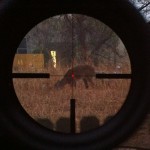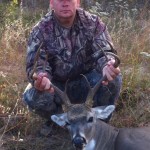By Staff Writer: Charles Coker
Being an avid hunter that wants to make sure he has the ability to shoot accurately into extremely low light I am always on the prowl for good optics to get the job done. Today I compare two very well rated scopes for low light hunting.
I have spent the last few months testing these scopes and comparing against each other in low to no light.
What makes a scope a good low light hunting scope?
- An illumination system that isn’t too bright!
- Great glass
Too many scopes feature an illuminated reticle that is TOO bright, even at it’s lowest setting. This causes your iris to contract and thereby limiting the amount of light that is allowed in, so, great, you have a nice bright illuminated reticle but can’t see the deer or hog anymore! Now, for a 3 gun scope a day time bright reticle that you can pick up fast is ideal. But for actual hunting all you need/want is a dimly lit dot at the center crosshair section.
Both are well made and feature similar specs. The biggest differences are the illumination system. The Trijicon uses a combination of Tritium and Fiber Optics to provide the reticle illumination. I chose the mil dot reticle with a small center dot that illuminates. With sunlight the Fiber Optic picks up the light and thus lights up the center dot, you can adjust the intensity via a cover that slides over the Fiber Optic piping. This can be useful if the reticle is too bright and causing blooming in bright sun. Once the sun drops the Tritium glows and provides the illumination. I am a big fan of Trijicon Accupoints as I feel they feature very good glass and a well thought out illumination system. The Meopta uses a battery to power an LED that emits light from inside the scope tube and the back of the reticle reflects that back to the user. I have used Trijicon Accupoints for some time and own a 3-9×40 with the mil dot reticle with a center green dot. My son absconded that scope from me 2 years ago and it now sits on his 243. He is deadly with it. The Meopta is a scope I have been wanting to test for some time as I have heard they have excellent glass and a very well done illuminated reticle. I chose the #4 reticle with an illuminated center dot and the reticle is in the 1st focal plane.
Both scopes feature 30mm tubes with 56mm objectives. Contrary to some people’s thoughts the 30mm tube does nothing for “light gathering”. My experience doing direct A/B comparisons of the same scope is that a 50mm provides around 5 more minutes of usability (brightness and resolution) over a 40mm and a 56mm yeilds another 2-3 over a 50mm.
Yes, they are bigger and heavier but if absolute best low light performance is your goal, they are worth it. For deer hunting that may mean you see a big buck at last possible shooting light and you can determine if it is one you should pull the trigger on or not. For those that hunt heavily managed properties where shooting the wrong buck can get you into hot water, the difference is worth it. For hog hunting under moonlight, it helps out as well of course.
I will go on record saying I think that for deer hunting, at least for whitetails that very good glass and a bold reticle is sufficient at least to my eyes. If it gets dark enough that you can only see it through the scope, i.e., invisible to the naked eye, then great glass will enable you to see it and a bold reticle will enable you to place the shot into the vitals on a light skinned deer due to the contrast. For a dark colored hog, great glass and a good illuminated reticle is a must. My personal take is not to shoot past maximum point blank range when it is that dark. So, no need for lit up Christmas tree for holdovers. In fact, I think those tactical style reticles are a bad choice for low light shots for hunting.
So, how do they stack up against each other ?
Reticle choice
I chose the 4c reticle for the Meopta as I have always liked #4 reticles for low light use. Even without a lit center dot I can basically triangulate the center with the bold vertical and bottom posts if I lose the thin center crosshair. With the Trijicon I chose the Mil dot reticle as I like the system for determing hold over points as well as ranging and even measuring remotely in the field. Like, a buck at 100 yards and using the Mil dot system to measure antler width or height. I could have chose a #4 and perhaps that would have been a more direct A/B compare but I also think it’s sort of a mute point given I am testing the glass and the illumination system.
Glass Comparison
Well, as good as the Trijicon is, the Meopta is a tad better. You can see this in very low light and it is the resolution and contrast that matters as much as the brightness. Being able to count points, height, width, etc.. on a buck at 150 yards nestled up in the trees. In fact, I would say the Meopta is as good as my S&B, Kahles, Zeiss or a Swarovski. Yes, it IS that good. In particular it is the contrast that makes things pop out and provide distinction, i.e., a set of antlers. Meopta glass is made by Schott and they do their own coatings.
Illuminated Reticle
This is a little harder to call. The Trijicon’s dot is a smaller and therefore perhaps a bit better for longer shots as it covers less of the target. Both get VERY dim and from that perspective is as good as it gets. In fact, the Meopta’s dot appears VERY similar to my S&B Flashdot when lit. The Trijicon can be seen during bright day light daylight whereas the Meopta can not, but, that is far from a show stopper for me as the #4 reticle is very bold and the center dot (not illuminated) is very fast to pick up. The Meopta has a 7 position knob on the left of the scope with an off setting between each power setting. A good feature in my mind.
Magnification Range
The Trijcion is 2.5-10 versus the 3-12 of the Meopta. Hard to call a win here as the Trijicon has a tad bigger field of view at low power and the Meopta a tad more magnification at high power. I don’t personally see that much difference assuming similar glass between a 10x and a 12x at typical hunting distances of say 400 and under. There is a difference but it’s not that much between 10 and 12. Alternatively, I don’t really see that much real world difference on the bottom end for close in hunting.
Eye Relief, ease of getting behind the scope
One thing that has concerned me on the specs for the Trijicon is the supposedly varying eye relief of 2.8-41″. I really could not detect that and I was able to maintain a constant cheek weld with a good view at all power settings. At 10X however, there was a tiny bit of eye position sensitivity. The Meopta had a constant eye relief though a bit short at 3.5″ which MAY cause some concern with a hard kicking rifle. On my 280 Ackley, no such issues. There was a bit of tunneling at lowest power on the Meopta that was removed by slightly bumping up the power to like 3.2, it did not reduce my field of view however. I felt at 10x – 12X the Meopta was more forgiving and caused less eye strain.
Pictures through the scope:
I took some pictures of deer about 100 yards behind my house this evening as the light faded. It was also a very overcast evening with a light mist in the air.
It is hard to get a great picture of a reticle in bright light and even harder as light begins to fade. This is not for you to try to judge the glass but to show you the reticles, both set at 10x.
Meopta (click to enlarge)
Trijicon (click to enlarge)
Overall winner:
In all honesty, I can’t call it. You need to look at your hunting needs and prioritize. They both have pros and cons.
The Trijicon has a mil dot reticle so it has holdover points for longer range use and is a tad lighter.
The Meopta has slightly better glass and a bit more magnification but is also a tad heavier.
I would perhaps say the Trijicon is a bit more versatile whereas the Meopta is the clear winner if you if being able to judge a set of antlers at last possible light is a bigger priority.
If hunting dark hogs at night, either would serve you well. If you crave the best glass, then the Meopta gets the vote, it is damned good.
Both are top notch scopes that would make just about any hunter happy.
Street price puts the Meopta about a hundred bucks more.
I have yet to pull the trigger on game with the Meopta but did take a nice management buck with the Trijicon
Specifications
Trijicon TR22
Magnification Range: 2.5-10
Objective Size: 50mm
Reticle plane: 2nd
Tube Diameter: 30mm
Length: 13.8″
Weight: 20.7 oz
Eye Relief: 2.8-4.1
Reticle: Mil Dot with illuminated center dot (amber)
Meopta MeoStar R1 3-12×56 RD
Magnification Range: 3-12
Objective Size: 56mm
Reticle plane: 1st
Tube Diameter: 30mm
Length: 14.37″
Weight: 22.93 oz
Eye Relief: 3.5″
Reticle: #4 with illuminated center dot (red)
Latest posts by Charles Coker (see all)
- Millertech LifeP04 deep cycle battery – September 20, 2024
- Bart’s Bay Armor Protective Wading Boots – July 14, 2022
- Big boar down – March 30, 2022


Leave a Reply